A Runner’s Guide to Visiting Boston
As the site of one of the most prestigious marathons, Boston boasts one of the largest and most vibrant running scenes in the United States. Sure, Boston is a bit more urban than professional training havens like Boulder or Flagstaff. But the city’s historical ties to the sport and large, active amateur running club scene give Bostonian running culture a uniquely warm and rowdy charm. The city’s deep, unconditional love for the sport is perhaps most evident during brutal winter months when hordes of runners can be seen braving snow, ice, and subzero temperatures. Come spring when racing fever hits, the community’s tremendous collective pride around its beloved marathon infiltrates the whole city.
Boston is home to the headquarters of several prominent running companies, including Reebok, New Balance, Saucony, Puma, Heartbreak Hill Running Company, and the New England apparel brand Tracksmith. The city is also the training ground for a number of prestigious running groups, including the Boston Athletic Association—one of the nation’s oldest athletic clubs.
Whether you’re planning to visit Boston in April for the marathon or at a quieter time of year, here’s our guide to the city’s running culture, featuring advice from local runners on their favorite trails to explore, races to enter, and spots to grab a post-run beer.
What You Need to Know Before Visiting Boston

It’s not that big. Compared to other major American cities, Boston is relatively compact. The city is remarkably walkable and runnable, and a variety of unique trails and routes are quite accessible. Because of the city’s size and public transportation system, you don’t need to rent a car to get around while visiting. (Plus, Boston is infamous for its confusing roads.) Instead, consider buying a seven-day T pass or a CharlieCard.
There is a lot of urban greenspace. According to data from the Trust For Public Land, all Boston residents live within a ten-minute walk of a park. While Boston evokes images of cobblestone streets, historical landmarks, and bustling crowds of college students, it’s also known for its picturesque city runs throughout the Emerald Necklace trails and along the Charles River.
Fall and spring are the best running seasons. The summer months are the peak tourist season, but the best times to visit for running and racing are fall and spring. Ideal running weather arrives in September, when New England turns cooler and crisp, and running through the city’s parks offers top-notch foliage in October. While Boston can be drizzly in the spring, the showers summon breathtaking floral blooms. And of course, spring means marathon season in Boston: the third Monday in April is Boston Marathon day.
Local Running Scene
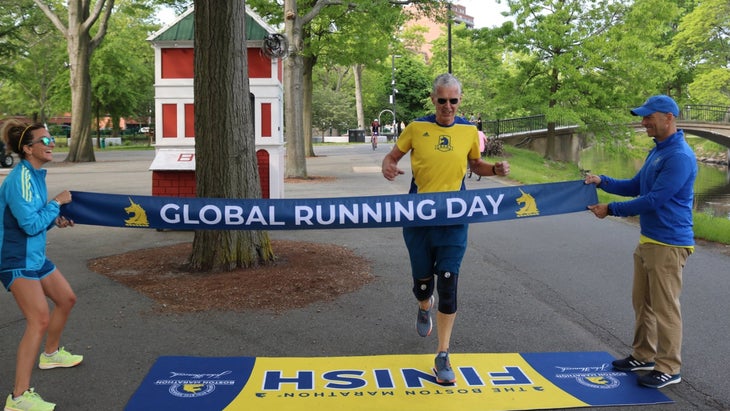
Boston is an active city, and the magnetic force of the Boston Marathon makes running a popular activity for people of all ability levels. Though Boston doesn’t have the cheeriest reputation, local runners say the community around the sport is among the most inclusive and social in the nation.
“The Boston running community is huge, competitive, and welcoming,” says Erika Kemp, a runner for the B.A.A. High Performance Team and two-time USATF national champion. “I was amazed when I first moved to Boston and saw so many individuals from all different backgrounds running on any given day.”
In addition to elite teams, Boston is also home to fun-loving groups like the Midnight Runners Boston powered by Reebok, who sit happily in the middle of the pack, prioritizing fun and inclusivity. They can be found running around the Charles River Esplanade, blasting music, and grabbing drinks afterward. “We’re not exclusive,” says club member Carolyn Cohen. “People will run with multiple different clubs in one week just because there are so many.”
Races and Running Events
The Marathon and Other B.A.A. Races
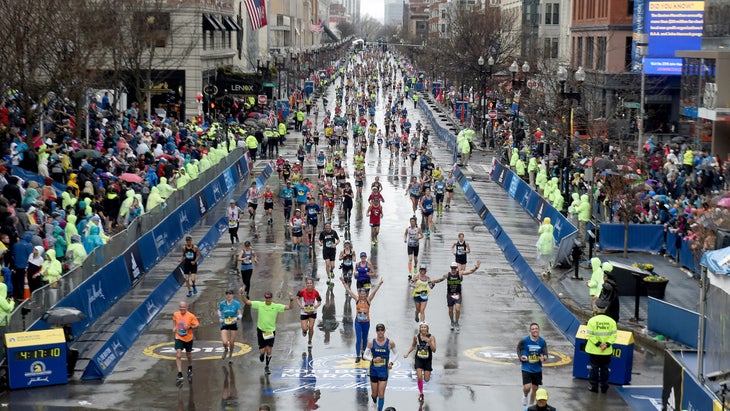
The Boston Marathon needs no introduction: as one of the six Marathon Majors and the world’s oldest marathon, the event attracts 500,000 spectators each year—making it the region’s most widely viewed sporting event. “I’ve already taken that day off of work to go and cheer everyone on,” says Andrew Wilson, a local runner for the Midnight Runners Boston.
The marathon is organized by the Boston Athletic Association and has been held every year since 1897, except for 2020 when the race was replaced by a virtual event during the pandemic. The point-to-point course begins in Hopkinton, southwest of Boston, and ends on Boylston Street in downtown Boston. The Boston Marathon is known for its challenging qualifying standards, but the race organizers also reserve a few thousand slots for runners affiliated with particular charity organizations. The 2022 race field will be limited to 20,000 runners due to the pandemic, compared to the usual 30,000 in recent pre-pandemic years.
In addition to the marathon, the Boston Athletic Association also hosts the B.A.A. Distance Medley race series: a 5K on the weekend of the Boston Marathon, a 10K in late June, and a half marathon in October.
“It is a well-structured and fun series of races that people can build towards all year long,” says Kemp.
The B.A.A. also puts on the Mayor’s Cup cross-country race in October, in partnership with Adidas. The race takes place in historic Franklin Park and is open to all ages. The women’s championship distance is 5K while the men race 8K.
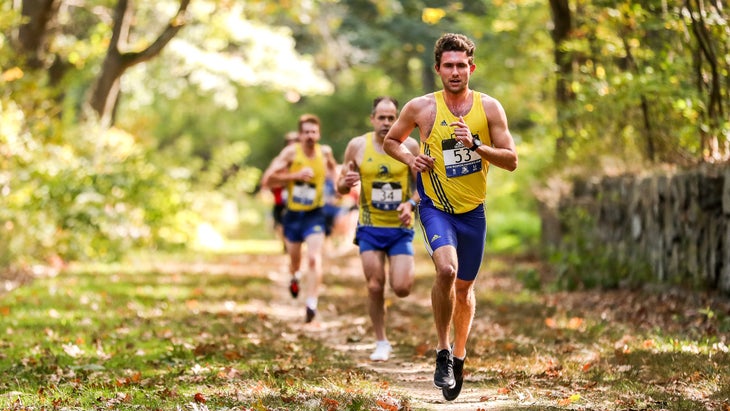
Fun Runs
If your visit doesn’t line up with these marquee events, there are plenty of more casual races in the area throughout the year. If shorter distances are more your speed, the Cambridge Classic 5K Series hosts three 5Ks throughout the year that start and finish in downtown Cambridge.
The Harpoon 5-Miler is another popular choice, attracting around 5,000 runners to the Harpoon Brewery in Boston’s Seaport District. The race is usually held in late May and takes runners 2.5 miles out and back on a route that overlooks Boston Harbor. “Harpoon does a really good job. It’s a pretty fun after-party,” says Louis Serafini, a runner and community organizer with Tracksmith.
If you’re brave enough for a winter race near Boston, the Super Sunday Five Miler on Super Bowl Sunday is a road race in Cambridge with a fun after-party and one of the few winter road races in the city.
Flat and Fast
Visiting Boston over Memorial Day Weekend? Boston’s Run to Remember offers a half marathon and a five-mile race. The five-miler begins at the Seaport Hotel and takes participants on a flat, fast course through downtown Boston, passing several landmarks like the Boston Common, the Public Garden, Faneuil Hall, and the Old State House.
One of the most popular events for competitive runners trying to qualify for the Boston Marathon is the Baystate Marathon and Half Marathon—both distances take place in October on a lightning-fast course in Lowell, Massachusetts, about 40 minutes north of Boston. Also in October, the Boston 10K for Women attracts elite competition and runners of skill levels to its fast course through Boston’s Back Bay on Indigenous People’s Day weekend.
Where to Run
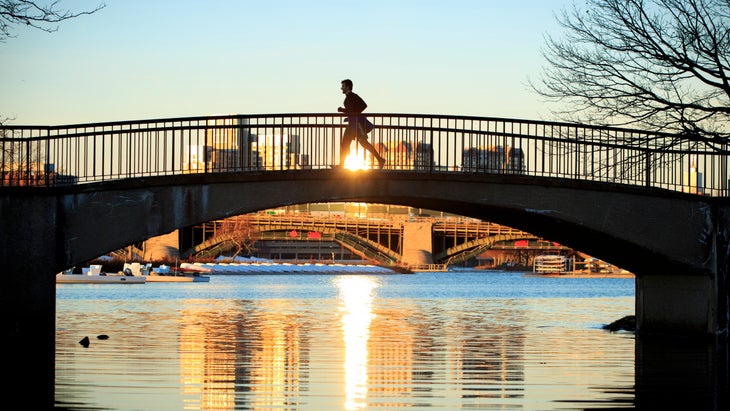
The Charles River Esplanade, Back Bay
The Esplanade is a fan favorite among runners in the area for its accessibility from downtown and beautiful views of the city. It’s also safe from traffic and ideal for directionally challenged runners. The main access point is from Science Park in downtown Boston, where it extends nine miles on both sides of the river to Watertown, but you can keep going all the way to Waltham and Newton. Because a number of bridges cross along the way, you can run a loop of almost any length.
“I’ve done loops as short as three miles and as long as almost 20,” says B.A.A. Running Club member Mike Paulin. For example, a run from the Museum of Science to Newton and back would be about 20 miles.
The Emerald Necklace
The Emerald Necklace is a 1,100-acre system of linked green spaces and waterways that runs for seven miles from downtown Boston, past Fenway, and on to several parks. It’s a great way to see several city sights in one run and offers a number of options.
Serafini suggests the Muddy River or River Path through the Back Bay Fens, an urban wild space and parkland. “People go straight for the Charles River, but Riverway is totally flat and has two sides to it. It’s great if you are trying to run on a soft surface because you can run on gravel and dirt for most of it,” he says. You can run the trail all the way out to Jamaica Pond, which has a beautiful 1.4-mile loop around it.
Another popular option is Franklin Park—Boston’s largest open space at 485 acres. The park sits smack-dab in the center of the city and hosts a number of high school and college cross-country races. It’s a good place to go if you’re looking for some well-groomed, grassy trails.
The Emerald Necklace continues out to Harvard University’s Arnold Arboretum—which is a gorgeous run in the spring thanks to its botanical diversity.
Fresh Pond Reservation Loop Trail and the Minuteman Bike Path, Cambridge
The traffic-free, paved 2.5-mile loop around Fresh Pond in Cambridge is about five miles from downtown Boston. It has bathrooms and water fountains, and it’s a great place for longer interval repeats. A bike trail also connects to the Minuteman Bike Trail—a ten-mile paved trail for pedestrians and cyclists that passes through the nearby towns of Lexington and Arlington.
The Battle Road Trail, Concord
Many of Boston’s best runners do their long runs on this is soft-surface trail 20 to 30 minutes outside the city. British soldiers marched the route to the opening battle of the American Revolution in April of 1775, so it stops at a handful of historical landmarks. Note: if you’re visiting in the winter, save this one for your next trip.
The Boston Marathon Course, Newton
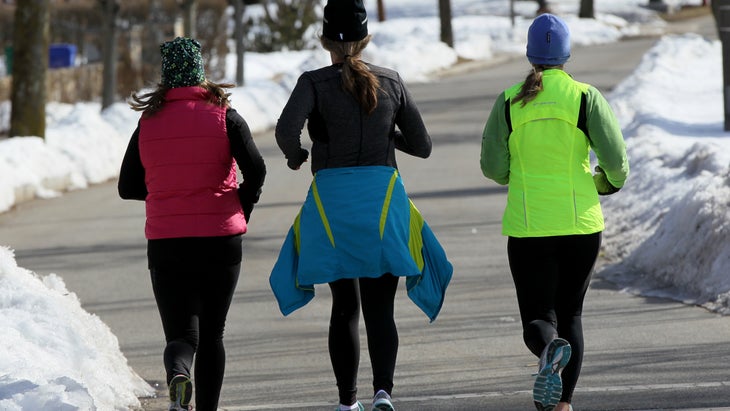
For a classic long run, start in Newton to run the last ten miles of the Boston Marathon course. You can take the Green Line D train to the Woodland stop, just over the hill from the course between miles 16 and 17. From there you can run up Heartbreak Hill, alongside Boston College and Fenway Park, and finish on Boylston.
If you visit Boston in the winter, Commonwealth Avenue (a.k.a. Comm Ave.) on the Boston Marathon course is a popular choice among local marathoners in training. In the Newton hills, there’s a carriage lane that’s usually plowed for runners. “If you go on a weekend, the carriage lane is filled with runners training for the Boston Marathon,” says Serafini.
Boston Common, Downtown Boston
While there aren’t many open tracks in or around Boston, the path around Boston Common is almost exactly a one-mile loop. It also includes an incline if you’re trying to work in some hill training.
Where to Stay
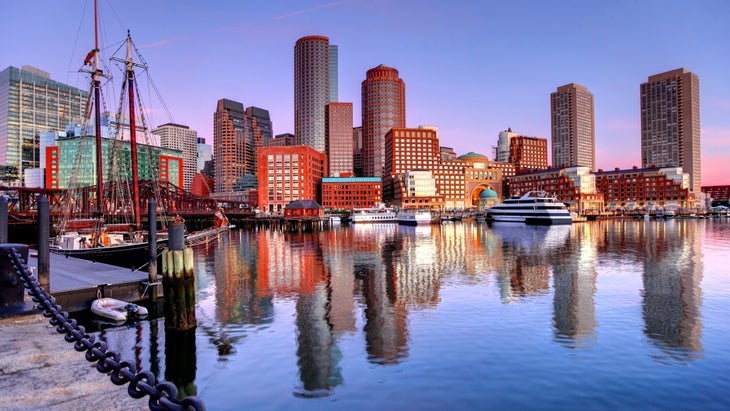
For a central and lively area close to historical landmarks, downtown Boston is a classic option. Choose Back Bay for a buzzing neighborhood near the Boston Marathon Expo and finish line. It’s also the home of Tracksmith’s Trackhouse, a hangout for runners. Baseball fans should opt for Fenway, another central and historic neighborhood near the Boston Marathon finish line. The Charles River running routes are easy to get to from all three.
For an up-and-coming neighborhood, the Seaport is popping with shops, breweries, and restaurants. From there you can quickly get to scenic running routes along the South Boston waterfront.
Hoping for something a little more quaint when it’s time to retreat for the night? Consider staying in Boston’s South End or over the river in Cambridge or Somerville.
Where to Fuel (and Drink) Up
Brunch and Quick Bites
Serafini says the Tracksmith running group’s favorite place to grab a post-run breakfast is Trident Booksellers and Cafe, an indie bookstore with an all-day breakfast menu, located right by the Trackhouse. Another breakfast spot popular with area runners is The Friendly Toast. “They do an awesome brunch and also have plenty of options for mimosas and other drinks,” says B.A.A. Race Team member Allie Hacket.
For a pre-run cup of coffee, Tracksmith’s Boston community organizer and co-captain of the Unnamed Run Crew, Leandrew Belnavis, recommends Render Coffee over on Boston’s South End: “Order the malted cold brew and thank me later!” If you have a hankering for a post-workout refreshment in Back Bay, hit up Jugos and Supremo—an all-natural juice and smoothie bar with a few small bites. Belnavis recommends ordering the Super Linda (pineapple, mango, banana, coconut, and orange). Another quick, healthy meal in Boston’s Back Bay neighborhood that Kemp suggests as a good pre-race option is Dig in Copley Square, which serves fresh and seasonal food.
Dining
Boston offers an eclectic variety of restaurants. Traditionally the city is known for its seafood (fried clams and chowdah), authentic Italian food, Irish pubs, and famous baked beans. If you’re looking for old-school Boston food (and perhaps pre-race carbs), hit the city’s North End and Beacon Hill neighborhoods, where the cuisine is heavily influenced by the city’s Italian heritage. For fantastic flatbread pizza and a cozy ambiance, Hacket recommends Figs by Todd English on Charles Street.
Head over to Boston’s South End for a melting pot of trendy, international dining experiences. Belnavis suggests Kava Neo Taverna for authentic Greek food and Banyan Bar for Asian fusion and a great dumpling happy hour. For Boston’s famous seafood, area runners say to check out Saltie Girl in Back Bay’s Copley Square or Row 34 on the Seaport. Adventurous diners can head over to Fenway to check out TimeOut Market—a dining hall that brings the best of Boston’s culinary culture under one roof.
Breweries
Although you won’t find any happy hours—Boston is infamous for its puritanical drinking regulations that outlaw deals on drinks—the city’s craft beer and microbrewery scene is renowned. In addition to famous mainstream breweries like Sam Adams and Harpoon, there are also a number of up-and-coming breweries. A popular one among local runners is Night Shift Brewing’s Esplanade location (called Owls Nest), a beer garden by the river that also serves innovative food. In downtown Cambridge, Lamplighter Brewing Company specializes in New England IPAs. Trillium is another favorite that offers a rotating beer selection and indoor and outdoor seating. It has three locations in the city: Fenway, Fort Point, and Greenway.
Runners who are into dive bars should check out Bukowski Tavern for a great beer selection and late-night food, or Beantown Pub, where you can grab a burger, play pool, and have a Sam Adams just yards away from none other than Sam Adams himself. He’s buried across the street. For a funky hangout over on Boston’s South End, one of Serafini’s favorite spots is the Beehive—a dim underground jazz club with bohemian vibes, a vintage cocktail list, and a slick patio.
